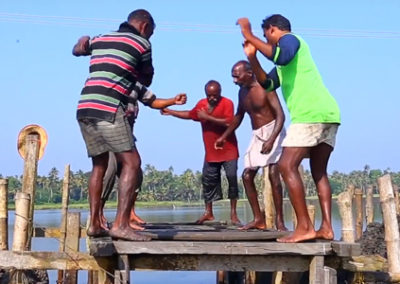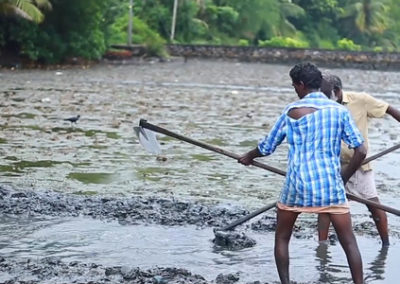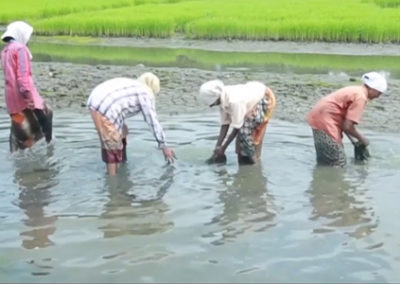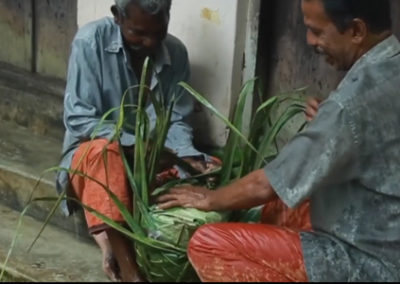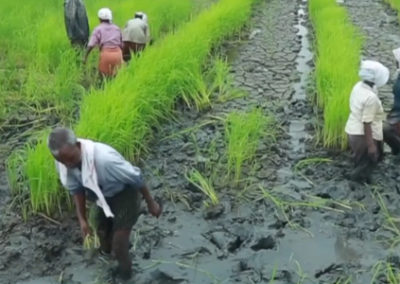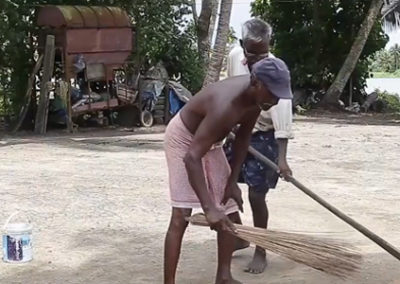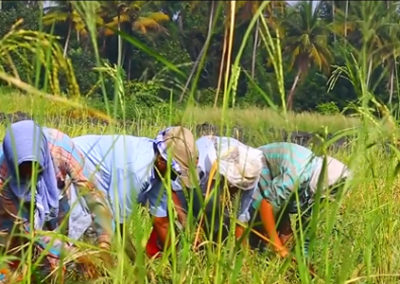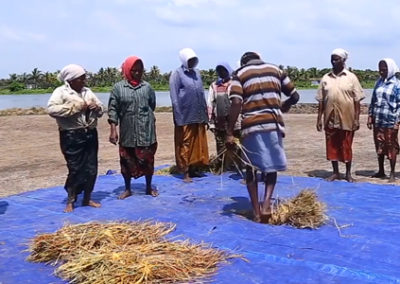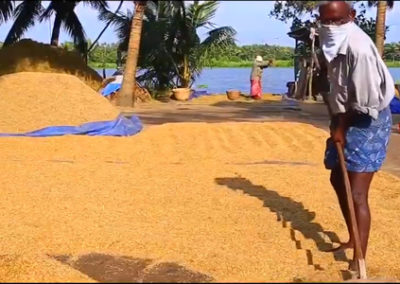
FARMING METHOD
Preparation of the field
In more than 90 % of the single cropped Pokkali lands, rice cultivation is done during the low saline phase from May-June to September-October. The traditional prawn filtration is taken up during the high saline phase which sets in during December-January.
The bunds are strengthened by April and sluices (wooden gates) are repaired for regulating water level. The fields are drained during low tide and then sluices are closed. The monsoon rain washes down the dissolved salts in the mounds formed in the previously dried fields. The mounds act as elevated in-situ nursery and protect the seedlings from flash floods.
The Pokkali system mainly depends on traditional Pokkali cultivars and high yielding varieties derived from these cultivars. Pokkali, Churuttu Pokkali, Chettyviruppu,Anakkondan and Cheruviruppu are the traditional cultivars prevalent in this tract. Improved varieties developed from the Rice research Station. Vyttila (VTL-1 to VTL-8) Kerala Agricultural University, are now popular mainly with respect to high yield.

Seeds Preparation
A method unique to Pokkali is adopted for sprouting the seeds. The seeds are tightly packed in baskets made of plaited coconut leaves the inside of which are lined by banana or teak leaves. These baskets are then immersed in fresh water ponds for 12 – 15 days. After which they are taken out and stored in shade. During this time the seeds sprout and remain dormant for more than 30 days in that condition.
When the soil and weather conditions become favorable for sowing, the baskets containing the seeds are re soaked for 3 to 6 hours before sowing. The mounds in the field are then raked and levelled, the sprouted seeds are sown on the top of mounds which act as nursery in-situ.
Organically fertilized
Generally manuring or plant protection operations are not necessary for pokkali farming systems. The crop matures in a trout for 12 days. The average yield of rice with traditional rice varieties is 1500 kg / ha. After harvest of rice the field is used for fish or prawn capture, which provides a substantial subsidiary income to the farmer. Prawn filtration is resorted in areas where tidal amplitude is high.
Keeping the water level low in the field during high tide, water is let into the field by opening the shutters, which allows the prawn larvae into the fields along with the inflow. A hurricane lantern is hung at the sluice mouth to attract the prawn larvae. During low tide water is let out through a bamboo screen, which prevents escape of fish and prawn already entered into the field and brings down the water level, so that water can again be taken in during high tide. The actual fishing operation starts by the middle of January coinciding with the lunar phase. The prawn filtration net is also unique to the Pokkali farming methods. It is conical in shape having a total length of 4-5 feet with a trap system in the middle and a valve at the code end for easy collection of the catch. Luring in of prawns continues simultaneously along with fishing till the end of March, when the fields are finally drained for paddy cultivation. In Pokkali cultivation where no chemical fertilizers are added, tidal ingress plays an important role in maintaining the nutrient status of the soil. In addition a plethora of microorganisms flourish in the system which ultimately keep the soil very productive. But more significant is the annual transition from low saline to high saline phase such that the stenohaline fauna and flora dies out, decomposes and adds to soil fertility.
Integrated Farming Method
Pokkali integrated farming of rice and prawn is considered to be an essential part of farming systems in the low-lying lands. Rice-Prawn rotational culture in Pokkali fields is undertaken on a collective basis. With limited expenses under this system, a fish yield of 3 to 5 tons per hectare is attained on an average. Moreover, the rotational farming of rice and fish improves the soil conditions and thereby increases rice yields in the next season up to 15-20 per cent. Since rice farming in Pokkali fields is purely organic, the cost of chemical fertilizers would be zero.
It is estimated that the traditional paddy farming yields a profit of only 25,000/- per ha. whereas paddy and prawn together (as in Pokkali) yield a profit of INR 50,000- per ha. This could be augmented to 1.3 Lakhs per ha in the newly introduced Paddy-shrimp-cage culture integrated system introduced by Central Marine Fisheries Research Institute (CMFRI). Subsequent to the success of this integrated farming, the Fish Farmers Development Agency (FFDA) under the State Government has initiated a subsidy scheme – Integrated fish farming in Pokkali fields.
Prawns constitute about 80% of the catch and fishes (and occasionally crabs) about 20%. The Prawns species are Metapenaeus dobsoni, Metapenaeus monoceros, Penaeus indicus, Penaeus monodon etc. Local/ Malayalam names of prawns are ‘Thelly’, ‘Choodan’, ‘Naaran’ and ‘Kaara chemmeen’. Fishes include Tilapia mossambicus, Etroplus suratensis, Etroplus maculatus, Mugil cephalus, Anabas testudineus etc (Tomy et al. 1984). Local/ Malayalam names are karimeen, tilapia, kanambu, koori, poolan, pallathi etc The crabs include Scylla serrata, S. tranquebarica and Portunus pelagicus.
Sources:
1. CPGD – Kerala, Report for National Adaptation Fund, ‘Promotion of Integrated Farming System of Kaipad and Pokkali in Coastal Wetlands of Kerala 2015-2016 TO 2018-2019’.
2. Dr. Venugopal B., ‘Study of the Indigenous Method of Agriculture Practice called Pokkali’. Centre for Intangible Heritage Studies, Sree Sankaracharya University of Sanskrit, Kalady, Kerala.

